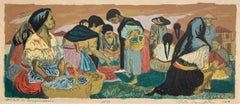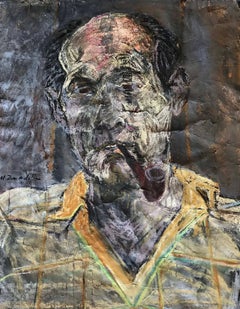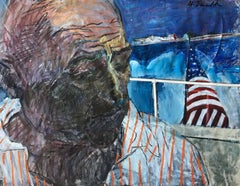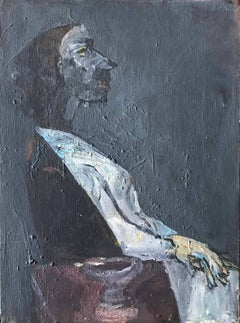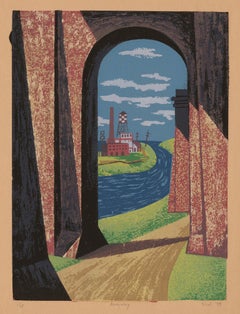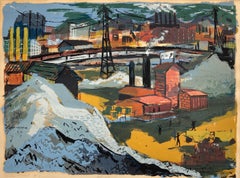Morton Dimondstein Art
to
2
4
1
1
Overall Height
to
Overall Width
to
1
3
2
2
1
1
1
1
1
1
4
1
1
2
4
6,886
3,209
2,514
1,217
3
3
3
3
1
Artist: Morton Dimondstein
MARKET IN ERONGARICUARO
By Morton Dimondstein
Located in Santa Monica, CA
MORTON DIMONDSTEIN (NY 1920 - LA 2000)
MARKET IN ERONGARICUARO 1954
Serigraph, silkscreen. Signed titled and dated in pencil. Image 10 ¼ x 25 ½ inches. Large full sheet 17 1/4 x 30...
Category
1950s American Modern Morton Dimondstein Art
Materials
Screen
PORTRAIT OF CHARLIE KELLER
By Morton Dimondstein
Located in Los Angeles, CA
"PORTRAIT OF CHARLIE KELLER"
ARTIST
OIL ON PAPER
C.1970
23 X 17.5 INCHES
Morton Dimondstein
1920-2000
At the age of seventeen Morton Dimondstein enrolled in the American Artists School and then the Art Students League in New York City, where he studied painting, drawing, and printmaking with Anton Refregier, Harry Sternberg, and Kimon Nicolaides.
After serving in the 387th Field Artillery Battalion during World War II, Dimondstein continued his studies at the Otis Art Institute in Los Angeles. He was one of the first artists to produce serigraphic prints on the West Coast, marketing them as affordable art in galleries and retail stores.
His prints and oil paintings garnered several awards during this post-war period, including an A.C.A. Gallery international competition for a one- man show in New York City.
In 1951 he moved to Mexico, where he attended the Instituto Politécnico Nacional and studied art with José Gutiérrez and David Alfaro Siqueiros. During his three years in Mexico, Dimondstein worked as a staff artist and instructor in visual education for UNESCO and was a member of the Taller de Gráfica Popular.
After moving back to Los Angeles, Dimondstein served as the art editor of the California Quarterly from 1953 to 1956. He briefly worked for the Saul Bass advertising firm where he designed books and book jackets, and collaborated on the ad campaigns for films such as William Wyler’s “The Big Country” and Otto Preminger’s “St. Joan.” Dimondstein received industry recognition for the images he created, but cranking out art for commercial ventures with strict deadlines was not for him.
He chose to leave that world in favor of working as an independent artist and art teacher. Over the years he taught at the Kann Art Institute, the New School of Art, the University of Southern California in Los Angeles, and the School of Fine Art which he established with UCLA faculty member Martin Lubner...
Category
1970s Morton Dimondstein Art
Materials
Oil, Rag Paper
PORTRAIT OF ANHALT PORTRAIOT
By Morton Dimondstein
Located in Los Angeles, CA
"PORTRAIT OF ANHALT PORTRAIOT"
FILM MAKER
OIL ON PAPER
C.1970
17.5 X 22.5 INCHES
Morton Dimondstein
1920-2000
At the age of seventeen Morton Dimondstein enrolled in ...
Category
1970s Morton Dimondstein Art
Materials
Oil, Rag Paper
PROFILE OF A WOMAN
By Morton Dimondstein
Located in Los Angeles, CA
"PROFILE OF A WOMAN"
OIL ON PANEL
C.1960
PAINTED IN ITALY
16 X 12 INCHES
Morton Dimondstein
1920-2000
At the age of seventeen Morton Dimondstein enrolled in the American Artists School and then the Art Students League in New York City, where he studied painting, drawing, and printmaking with Anton Refregier, Harry Sternberg, and Kimon Nicolaides.
After serving in the 387th Field Artillery Battalion during World War II, Dimondstein continued his studies at the Otis Art Institute in Los Angeles. He was one of the first artists to produce serigraphic prints on the West Coast, marketing them as affordable art in galleries and retail stores.
His prints and oil paintings garnered several awards during this post-war period, including an A.C.A. Gallery international competition for a one- man show in New York City.
In 1951 he moved to Mexico, where he attended the Instituto Politécnico Nacional and studied art with José Gutiérrez and David Alfaro Siqueiros. During his three years in Mexico, Dimondstein worked as a staff artist and instructor in visual education for UNESCO and was a member of the Taller de Gráfica Popular.
After moving back to Los Angeles, Dimondstein served as the art editor of the California Quarterly from 1953 to 1956. He briefly worked for the Saul Bass advertising firm where he designed books and book jackets, and collaborated on the ad campaigns for films such as William Wyler’s “The Big Country” and Otto Preminger’s “St. Joan.” Dimondstein received industry recognition for the images he created, but cranking out art for commercial ventures with strict deadlines was not for him.
He chose to leave that world in favor of working as an independent artist and art teacher. Over the years he taught at the Kann Art Institute, the New School of Art, the University of Southern California in Los Angeles, and the School of Fine Art which he established with UCLA faculty member Martin Lubner...
Category
1960s Morton Dimondstein Art
Materials
Oil, Rag Paper
Related Items
'Archway' — 1930s American Modernism, WPA
By Leon Bibel
Located in Myrtle Beach, SC
Leon Bibel, 'Archway', color serigraph, 1939, edition 25. Signed, dated, titled, and numbered ' /25' in pencil. A rich, painterly impression, with fresh colors, on buff wove paper; ...
Category
1930s American Modern Morton Dimondstein Art
Materials
Screen
Modernist Figurative Pop Art Etching and Aquatint "the Artist" Michael Mazur
By Michael Mazur
Located in Surfside, FL
Michael Mazur
"The Artist"
Hand signed and editioned from the edition of 50
1967
Michael Burton Mazur (1935-August 18, 2009) was an American artist who was described by William Grimes of The New York Times as "a restlessly inventive printmaker, painter, and sculptor."
Born and raised in New York City, Mazur attended the Horace Mann School. He received a bachelor's degree from Amherst College in 1958, then studied art at Yale.
Mazur first gained notice for his series of lithographs and etchings of inmates in a mental asylum, which resulted in two publications, "Closed Ward" and "Locked Ward." Over the years, he worked in printmaking and painting. His series of large-scale prints for Dante's Inferno won critical acclaim, and were the subject of a traveling exhibition organized by the University of Iowa in 1994. Later he concentrated on creating large, lyrical paintings which make use of his free, gestural brushwork and a varied palette. Some of these paintings were seen in an exhibition of 2002 at Boston University, "Looking East: Brice Marden, Michael Mazur, and Pat Steir." (See also Susan Danly, "Branching: The Art of Michael Mazur," 1997).
The Museum of Fine Arts, Boston, has acquired a definMichael Mazur received a B.A. from Amherst College in 1957, studying in his senior year at the Accademia di Belle Arti in Florence, Italy. He went on to earn both a B.F.A. and an M.F.A. from the Yale School of Art and Architecture in 1961. Mazur's first teaching job was at the Rhode Island School of Design from 1961 to 1964. He was awarded a Guggenheim Foundation fellowship for 1964–65. From 1965 to 1976, he taught at Brandeis University, and from 1976 to 1978 at Harvard University. As an artist, teacher, and writer, Mazur has been active in reviving the monotype process. He contributed an essay to the pioneering exhibition catalogue The Painterly Print, published by the Metropolitan Museum of Art in 1980. Mazur recently chaired the New Provincetown Print...
Category
Early 2000s American Modern Morton Dimondstein Art
Materials
Lithograph, Screen
"The Capture, " Jacob Lawrence, Harlem Renaissance, Black Art, Haitian Series
By Jacob Lawrence
Located in New York, NY
Jacob Lawrence (1917 - 2000)
The Capture of Marmelade (from The Life of Toussaint L'Ouverture series), 1987
Color screenprint on Bainbridge Two Ply Rag paper
Sheet 32 1/8 x 22 1/16 inches
Sight 29 3/4 x 19 1/4 inches
A/P 1/30, aside from the edition of 120
Signed, titled, dated, inscribed "A/P" and numbered 1/30 in pencil, lower margin.
Literature: Nesbett L87-2.
A social realist, Lawrence documented the African American experience in several series devoted to Toussaint L’Ouverture, Frederick Douglass, Harriet Tubman, life in Harlem, and the civil rights movement of the 1960s. He was one of the first nationally recognized African American artists.
“If at times my productions do not express the conventionally beautiful, there is always an effort to express the universal beauty of man’s continuous struggle to lift his social position and to add dimension to his spiritual being.” — Jacob Lawrence quoted in Ellen Harkins Wheat, Jacob Lawrence: The Frederick Douglass and Harriet Tubman Series of 1938 – 40.
The most widely acclaimed African American artist of this century, and one of only several whose works are included in standard survey books on American art, Jacob Lawrence has enjoyed a successful career for more than fifty years. Lawrence’s paintings portray the lives and struggles of African Americans, and have found wide audiences due to their abstract, colorful style and universality of subject matter. By the time he was thirty years old, Lawrence had been labeled as the “foremost Negro artist,” and since that time his career has been a series of extraordinary accomplishments. Moreover, Lawrence is one of the few painters of his generation who grew up in a black community, was taught primarily by black artists, and was influenced by black people.
Lawrence was born on September 7, 1917,* in Atlantic City, New Jersey. He was the eldest child of Jacob and Rosa Lee Lawrence. The senior Lawrence worked as a railroad cook and in 1919 moved his family to Easton, Pennsylvania, where he sought work as a coal miner. Lawrence’s parents separated when he was seven, and in 1924 his mother moved her children first to Philadelphia and then to Harlem when Jacob was twelve years old. He enrolled in Public School 89 located at 135th Street and Lenox Avenue, and at the Utopia Children’s Center, a settlement house that provided an after school program in arts and crafts for Harlem children. The center was operated at that time by painter Charles Alston who immediately recognized young Lawrence’s talents.
Shortly after he began attending classes at Utopia Children’s Center, Lawrence developed an interest in drawing simple geometric patterns and making diorama type paintings from corrugated cardboard boxes. Following his graduation from P.S. 89, Lawrence enrolled in Commerce High School on West 65th Street and painted intermittently on his own. As the Depression became more acute, Lawrence’s mother lost her job and the family had to go on welfare. Lawrence dropped out of high school before his junior year to find odd jobs to help support his family. He enrolled in the Civilian Conservation Corps, a New Deal jobs program, and was sent to upstate New York. There he planted trees, drained swamps, and built dams. When Lawrence returned to Harlem he became associated with the Harlem Community Art Center directed by sculptor Augusta Savage, and began painting his earliest Harlem scenes.
Lawrence enjoyed playing pool at the Harlem Y.M.C.A., where he met “Professor” Seifert, a black, self styled lecturer and historian who had collected a large library of African and African American literature. Seifert encouraged Lawrence to visit the Schomburg Library in Harlem to read everything he could about African and African American culture. He also invited Lawrence to use his personal library, and to visit the Museum of Modern Art’s exhibition of African art in 1935.
As the Depression continued, circumstances remained financially difficult for Lawrence and his family. Through the persistence of Augusta Savage, Lawrence was assigned to an easel project with the W.P.A., and still under the influence of Seifert, Lawrence became interested in the life of Toussaint L’Ouverture, the black revolutionary and founder of the Republic of Haiti. Lawrence felt that a single painting would not depict L’Ouverture’s numerous achievements, and decided to produce a series of paintings on the general’s life. Lawrence is known primarily for his series of panels on the lives of important African Americans in history and scenes of African American life. His series of paintings include: The Life of Toussaint L’Ouverture, 1937, (forty one panels), The Life of Frederick Douglass, 1938, (forty panels), The Life of Harriet Tubman, 1939, (thirty one panels), The Migration of the Negro,1940 – 41, (sixty panels), The Life of John Brown, 1941, (twenty two panels), Harlem, 1942, (thirty panels), War, 1946 47, (fourteen panels), The South, 1947, (ten panels), Hospital, 1949 – 50, (eleven panels), Struggle: History of the American People, 1953 – 55, (thirty panels completed, sixty projected).
Lawrence’s best known series is The Migration of the Negro, executed in 1940 and 1941. The panels portray the migration of over a million African Americans from the South to industrial cities in the North between 1910 and 1940. These panels, as well as others by Lawrence, are linked together by descriptive phrases, color, and design. In November 1941 Lawrence’s Migration series was exhibited at the prestigious Downtown Gallery in New York. This show received wide acclaim, and at the age of twenty four Lawrence became the first African American artist to be represented by a downtown “mainstream” gallery. During the same month Fortune magazine published a lengthy article about Lawrence, and illustrated twenty six of the series’ sixty panels. In 1943 the Downtown Gallery exhibited Lawrence’s Harlem series, which was lauded by some critics as being even more successful than the Migration panels.
In 1937 Lawrence obtained a scholarship to the American Artists School in New York. At about the same time, he was also the recipient of a Rosenwald Grant for three consecutive years. In 1943 Lawrence joined the U.S. Coast Guard and was assigned to troop ships that sailed to Italy and India. After his discharge in 1945, Lawrence returned to painting the history of African American people. In the summer of 1947 Lawrence taught at the innovative Black Mountain College in North Carolina at the invitation of painter Josef Albers.
During the late 1940s Lawrence was the most celebrated African American painter in America. Young, gifted, and personable, Lawrence presented the image of the black artist who had truly “arrived”. Lawrence was, however, somewhat overwhelmed by his own success, and deeply concerned that some of his equally talented black artist friends had not achieved a similar success. As a consequence, Lawrence became deeply depressed, and in July 1949 voluntarily entered Hillside Hospital in Queens, New York, to receive treatment. He completed the Hospital series while at Hillside.
Following his discharge from the hospital in 1950, Lawrence resumed painting with renewed enthusiasm. In 1960 he was honored with a retrospective exhibition and monograph prepared by The American Federation of Arts. He also traveled to Africa twice during the 1960s and lived primarily in Nigeria. Lawrence taught for a number of years at the Art Students League in New York, and over the years has also served on the faculties of Brandeis University, the New School for Social Research, California State College at Hayward, the Pratt Institute, and the University of Washington, Seattle, where he is currently Professor Emeritus of Art. In 1974 the Whitney Museum of American Art in New York held a major retrospective of Lawrence’s work that toured nationally, and in December 1983 Lawrence was elected to the American Academy of Arts and Letters. The most recent retrospective of Lawrence’s paintings was organized by the Metropolitan Museum of Art in 2020, and was accompanied by a major catalogue. Lawrence met his wife Gwendolyn Knight...
Category
1970s American Modern Morton Dimondstein Art
Materials
Screen, Paper
The Cat, Signed Print by Will Barnet
By Will Barnet
Located in Long Island City, NY
Artist: Will Barnet, American (1911 - 2012)
Title: The Cat
Year: 1997
Medium: Screenprint on Arches, signed in pencil
Edition: AP
Image Size: 16 x 7 inches
Siz...
Category
1990s American Modern Morton Dimondstein Art
Materials
Screen
Harry Shokler, Island Harbor
By Harry Shokler
Located in New York, NY
Harry Shokler used serigraphy to great advantage in this landscape. It's colorful and detailed.
It is signed in the image at the lower left. When printmakers began making serigraphs...
Category
1940s American Modern Morton Dimondstein Art
Materials
Screen
The Black Indian Chief by African American Artist Bai, Contemporary Art on Paper
By Bai (Carl Karni-Bain)
Located in New york, NY
The Black Indian Chief, 2024 by contemporary African American artist Bai (Carl Karni-Bain), is a 30 x 22in acrylic, oil pastel, and ballpoint pen portrait painting on etching paper. ...
Category
2010s Contemporary Morton Dimondstein Art
Materials
Oil Pastel, Acrylic, Rag Paper, Ballpoint Pen
II Cup of Joe
Located in San Francisco, CA
This artwork titled "II Cup of Joe" c.1990, is an original color serigraph by American artist Rickey Jewell Hohimer, 1946-2021. It is hand signed, titled and numbered 250/300 in pencil by the artist. The image size is 19.5 x 23.5 inches, framed size is 26.75 x 30 inches. The artwork is in excellent condition, the frame is slightly damaged at the top, and will be replaced by a new similar black frame when sold. This will bring the over all condition to excellent.
About the artist:
Although formally trained with a MFA in painting, Rickey Jewell Hohimer has used the styles of Van Gogh and Gaughin to reach for the spontaneity and simplicity of today's folk art. Hohimer creates figures which are not photos of reality; they are romantically stylized to encourage straightforward emotional responses both to the colorful images and to the situations in which they find themselves. Each of Hohimer's paintings lays out a basic story line to which viewers add their own details. "I want the viewer to become personally involved. My paintings offer a change from those which encourage extensive intellectualizing about what the artist is trying to convey. I want viewers to smile -- to enjoy the whimsical nature of what they are experiencing -- to feel it, not to analyze it!. His jazz paintings are stories on canvas of inspired musicians spontaneously making music of the moment. Life in the jazz age is clubs and nightlife beckoning to musicians to produce jazz art...
Category
Late 20th Century American Modern Morton Dimondstein Art
Materials
Screen
Original "Wagon Lits" pop art style serigraph travel by train poster
By Valerio Adami
Located in Spokane, WA
Original “Wagon Lits” serigraph poster by the artist Valerio Adami.
It was printed in France by GrafiCaza (Michel Caza), one of the finest serigraph companies on woven paper—in exce...
Category
1990s American Modern Morton Dimondstein Art
Materials
Screen
H 36 in W 24 in D 0.05 in
Torre Velasca
Located in Milano, MI
Urbex is the English acronym for urban exploration and is an activity that consists of searching for and locating abandoned infrastructure with the goal of visiting, photographing and conveying its contents, with particular involvement of methodologies from geography, anthropology, sociology to cultural studies.
Her works have been in the past approached to the works of Anselm Kiefer (b. 1945) and Giovanni Battista Piranesi (1720-1770), but in Gullotta's paintings the absence of color makes the spaces particularly ethereal, allowing them to be ideally lifted to new places and to new life.
An artist of international caliber who has decided to entrust her return to her homeland to Almach Art Gallery in Milan, while maintaining connections with important galleries, such as Marlborough Fine Art in London and Galerie Koch in Hanover.
The artwork represents the famous Velasca Tower in Milan.
This artwork was exhibited during the Daniela Gullotta...
Category
2010s Contemporary Morton Dimondstein Art
Materials
Sandstone
1970s Pop Art "Dancing Lessons #2" Green, Pink Silkscreen Mod Ballet Girl Print
By Joanne Seltzer
Located in Surfside, FL
there is a companion piece on a silver paper. A depiction of a ballet dancer, superimposed upon canceled dance class checks.
Joanne Seltzer was born in Philadelphia, Pennsylvania a...
Category
1970s American Modern Morton Dimondstein Art
Materials
Screen
Modernist Silkscreen Screenprint 'El Station, Interior' NYC Subway, WPA Artist
By Anthony Velonis
Located in Surfside, FL
screenprint printed in color ink on wove paper. New York City subway station interior.
Anthony Velonis (1911 – 1997) was an American painter and designer born in New York City who helped introduce the public to silkscreen printing in the early 20th century.
While employed under the federal Works Progress Administration, WPA during the Great Depression, Velonis brought the use of silkscreen printing as a fine art form, referred to as the "serigraph," into the mainstream. By his own request, he was not publicly credited for coining the term.
He experimented and mastered techniques to print on a wide variety of materials, such as glass, plastics, and metal, thereby expanding the field. In the mid to late 20th century, the silkscreen technique became popular among other artists such as Robert Rauschenberg and Andy Warhol.
Velonis was born into a relatively poor background of a Greek immigrant family and grew up in the tenements of New York City. Early on, he took creative inspiration from figures in his life such as his grandfather, an immigrant from the mountains in Greece, who was "an ecclesiastical painter, on Byzantine style." Velonis attended James Monroe High School in The Bronx, where he took on minor artistic roles such as the illustration of his high school yearbook. He eventually received a scholarship to the NYU College of Fine Arts, into which he was both surprised and ecstatic to have been admitted. Around this time he took to painting, watercolor, and sculpture, as well as various other art forms, hoping to find a niche that fit. He attended NYU until 1929, when the Great Depression started in the United States after the stock market crash.
Around the year 1932, Velonis became interested in silk screen, together with fellow artist Fritz Brosius, and decided to investigate the practice. Working in his brother's sign shop, Velonis was able to master the silkscreen process. He reminisced in an interview three decades later that doing so was "plenty of fun," and that a lot of technology can be discovered through hard work, more so if it is worked on "little by little."
Velonis was hired by Mayor LaGuardia in 1934 to promote the work of New York's city government via posters publicizing city projects. One such project required him to go on a commercial fishing trip to locations including New Bedford and Nantucket for a fortnight, where he primarily took photographs and notes, and made sketches. Afterward, for a period of roughly six months, he was occupied with creating paintings from these records. During this trip, Velonis developed true respect and affinity for the fishermen with whom he traveled, "the relatively uneducated person," in his words.
Following this, Velonis began work with the Public Works of Art Project (PWAP), an offshoot of the Civil Works Administration (CWA), where he was assigned to serve the different city departments of New York. After the formation of the federal Works Progress Administration, which hired artists and sponsored projects in the arts, he also worked in theater.
Velonis began working for the federal WPA in 1935. He kept this position until 1936 or 1938, at which point he began working in the graphic art division of the Federal Art Project, which he ultimately led. Under various elements of the WPA program, many young artists, writers and actors gained employment that helped them survive during the Depression, as well as contributing works that created an artistic legacy for the country.
When interviewed in December 1994 by the Library of Congress about his time in the WPA, Velonis reflected that he had greatly enjoyed that period, saying that he liked the "excitement" and "meeting all the other artists with different points of view." He also said in a later interview that "the contact and the dialogue with all those artists and the work that took place was just invaluable." Among the young artists he hired was Edmond Casarella, who later developed an innovative technique using layered cardboard for woodcuts.
Velonis introduced silkscreen printing to the Poster Division of the WPA. As he recalled in a 1965 interview: "I suggested that the Poster division would be a lot more productive and useful if they had an auxiliary screen printing project that worked along with them. And apparently this was very favorably received..."
As a member of the Federal Art Project, a subdivision of the WPA, Velonis later approached the Public Use of Arts Committee (PUAC) for help in "propagandizing for art in the parks, in the subways, et cetera." Since the Federal Art Project could not be "self-promoting," an outside organization was required to advertise their art more extensively. During his employment with the Federal Art Project, Velonis created nine silkscreen posters for the federal government.
Around 1937-1939 Velonis wrote a pamphlet titled "Technical Problems of the Artist: Technique of the Silkscreen Process," which was distributed to art centers run by the WPA around the country. It was considered very influential in encouraging artists to try this relatively inexpensive technique and stimulated printmaking across the country.
In 1939, Velonis founded the Creative Printmakers Group, along with three others, including Hyman Warsager. They printed both their own works and those of other artists in their facility. This was considered the most important silkscreen shop of the period.
The next year, Velonis founded the National Serigraph Society. It started out with relatively small commercial projects, such as "rather fancy" Christmas cards that were sold to many of the upscale Fifth Avenue shops...
Category
1980s American Modern Morton Dimondstein Art
Materials
Screen
1970s Pop Art "Dancing Lessons #2" Silver Silkscreen Mod Ballet Girl Print
By Joanne Seltzer
Located in Surfside, FL
Printed on a slightly reflective metallic silver finished paper. there is a companion piece on a money green paper. A depiction of a ballet dancer, superimposed upon canceled dance c...
Category
1970s American Modern Morton Dimondstein Art
Materials
Screen
Previously Available Items
Industrial # 2
By Morton Dimondstein
Located in Santa Monica, CA
MORTON DIAMONDSON ((1920 - 2000)
INDUSTRIAL # 2, 1947
Serigraph. image, 11 1/4 x 15 1/2 inches Sheet 15 x 21 inches. Signed and titled on pencil. Mat burn surrounding the image in...
Category
1940s Modern Morton Dimondstein Art
Materials
Screen
The Jazz Soloist
By Morton Dimondstein
Located in Wiscasett, ME
Oil on canvas, signed and dated 1959
35” x 35”
Morton Dimondstein was born in New York in 1920 and at the age of seventeen, studied art at the American Artists School and then at the...
Category
1950s Cubist Morton Dimondstein Art
Materials
Oil
The Three Graces
By Morton Dimondstein
Located in Soquel, CA
Beautiful bronze sculpture with dark patina titled "Three Graces" by Morton Dimondstein. Size approximately 12"D X 14"H X 16"L. Add 4" for wood base. Unsigned. Titled and dated (Ame...
Category
1960s Abstract Expressionist Morton Dimondstein Art
Materials
Bronze
PORTRAIT OF MARTIN LUBNER
By Morton Dimondstein
Located in Los Angeles, CA
"PORTRAIT OF MARTIN LUBNER"
OIL ON CANVAS, SIGNED
DATED 1967
27 X 22 INCHES
Morton Dimondstein
1920-2000
At the age of seventeen Morton Dimondstein...
Category
1960s Expressionist Morton Dimondstein Art
Materials
Canvas, Oil
PORTRAIT OF JANET STEVENSON
By Morton Dimondstein
Located in Los Angeles, CA
"PORTRAIT OF JANET STEVENSON"
OIL ON CANVAS, SIGNED
DATED 1958
30 X 24 INCHES
Morton Dimondstein
1920-2000
At the age of seventeen Morton Dimondstein enrolled in the American A...
Category
1950s Expressionist Morton Dimondstein Art
Materials
Canvas, Oil
PORTRAIT OF MARTIN LUBNER PAINTING
By Morton Dimondstein
Located in Los Angeles, CA
"PORTRAIT OF MARTIN LUBNER PAINTING"
OIL ON PANEL, SIGNED
DATED 1958
31 X 29.5 INCHES
Morton Dimondstein
1920-2000
At the age of seventeen Morton D...
Category
1950s Expressionist Morton Dimondstein Art
Materials
Canvas, Oil
PORTRAIT OF DAVID AND FRANKIE LEMON
By Morton Dimondstein
Located in Los Angeles, CA
"PORTRAIT OF DAVID AND FRANKIE LEMON"
ARTISTS
OIL ON PAPER
C.1970
20.5 X 26 INCHES
Morton Dimondstein
1920-2000
At the age of seventeen Morton Dimondstein enrolled ...
Category
1970s Expressionist Morton Dimondstein Art
Materials
Oil, Rag Paper
Portrait of Manny
By Morton Dimondstein
Located in Los Angeles, CA
"MANNY"
FRIEND
OIL ON PANEL
C.1950S
9.5 X 8 INCHES
Morton Dimondstein
1920-2000
At the age of seventeen Morton Dimondstein enrolled in the American Artists School and then the...
Category
1960s Morton Dimondstein Art
Materials
Oil, Panel
PORTRAIT OF A MAN
By Morton Dimondstein
Located in Los Angeles, CA
"PORTRAIT OF A MAN"
OIL ON PANEL
C.1960
PAINTED IN ITALY
15 X 11 INCHES
Morton Dimondstein
1920-2000
At the age of seventeen Morton Dimondstein enrolled in the American Artist...
Category
1960s Expressionist Morton Dimondstein Art
Materials
Oil, Panel
Geraldine
By Morton Dimondstein
Located in Los Angeles, CA
"GERALDINE"
OIL ON PANEL
THE ARTIST'S WIFE
C.1960
13 X 24 Inches
Morton Dimondstein
1920-2000
At the age of seventeen Morton Dimondstein enrolled in the American Artists Schoo...
Category
1960s Expressionist Morton Dimondstein Art
Materials
Oil, Panel
Still Life
By Morton Dimondstein
Located in Los Angeles, CA
MORTON DIMONDSTEIN
"STILL LIFE"
OIL ON CANVAS, SIGNED
AMERICAN, C.1960, PAINTED IN ROME
21.5 X 25.25 INCHES
Morton Dimondstein
1920-2000
At the age of seventeen ...
Category
1960s Modern Morton Dimondstein Art
Materials
Canvas, Oil
The Artist at Work
By Morton Dimondstein
Located in Los Angeles, CA
"THE ARTIST AT WORK"
OIL ON CANVAS, ESTATE STAMPED
C.1960
31.5 X 29 INCHES
Morton Dimondstein
1920-2000
At the age of seventeen Morton Dimondstein...
Category
1950s American Modern Morton Dimondstein Art
Materials
Canvas, Oil
Morton Dimondstein art for sale on 1stDibs.
Find a wide variety of authentic Morton Dimondstein art available for sale on 1stDibs. You can also browse by medium to find art by Morton Dimondstein in oil paint, paint, paper and more. Customers who are interested in this artist might also find the work of Charles Quest, Tarmo Pasto, and Ruth Gikow. Morton Dimondstein art prices can differ depending upon medium, time period and other attributes. On 1stDibs, the price for these items starts at $950 and tops out at $1,200, while the average work can sell for $1,200.
